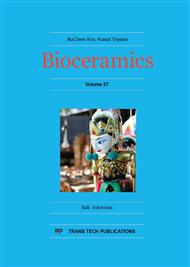p.223
p.230
p.234
p.238
p.245
p.250
p.259
p.265
p.271
Interface Function and Cefazolin-Adsorption-Release Characteristics of Hydroxyapatite Granules Modified by Supersonic Treatment Techniques
Abstract:
Commercial hydroxyapatite (HAp) porous granules were designed by the supersonic treatment at 120W and 38 kHz for 15 min in parenteral fluids (amino-acids (PF-A), electrolytes and carbohydrates (PF-EC), the mixtures (PF-M)) to form PF-A/HAp, PF-EC/HAp and PF-M/HAp. The modified HAp kept spherical shape and exhibited adhesive aggregates originated from parenteral fluid components on the surface layer. The BET specific surface areas decreased from 39 m2・g-1 to 19-24 m2・g-1. The granules dried at 293K were stirred at 309.5 K in 0.5-2.5 mg・cm-3 CEZ saline solutions. Adsorption isotherms of CEZ for all the granules almost obeyed the Langmuir type-equation. The amounts of CEZ adsorbed on the modified HAp were larger than those on HAp. Regarding CEZ-release characteristics in a biomimetic environment, the CEZ-adsorbed granules were freeze-dried or dried at 293K and they were stirred at 309.5K and pH 7.40 in simulated body fluid (SBF). The CEZ-release efficiencies for granules freeze-dried into SBF were significantly higher than those for granules dried at 293K. The values of granules freeze-dried were 37-43% for PF-A/HAp, 75-83% for PF-EC/HAp, and 56-64% for PF-M/HAp, which were related to the interface function, such as hydrophilicity of surface and multilayer film thickness of water molecule.
Info:
Periodical:
Pages:
265-270
Citation:
Online since:
May 2016
Price:
Сopyright:
© 2016 Trans Tech Publications Ltd. All Rights Reserved
Share:
Citation:


